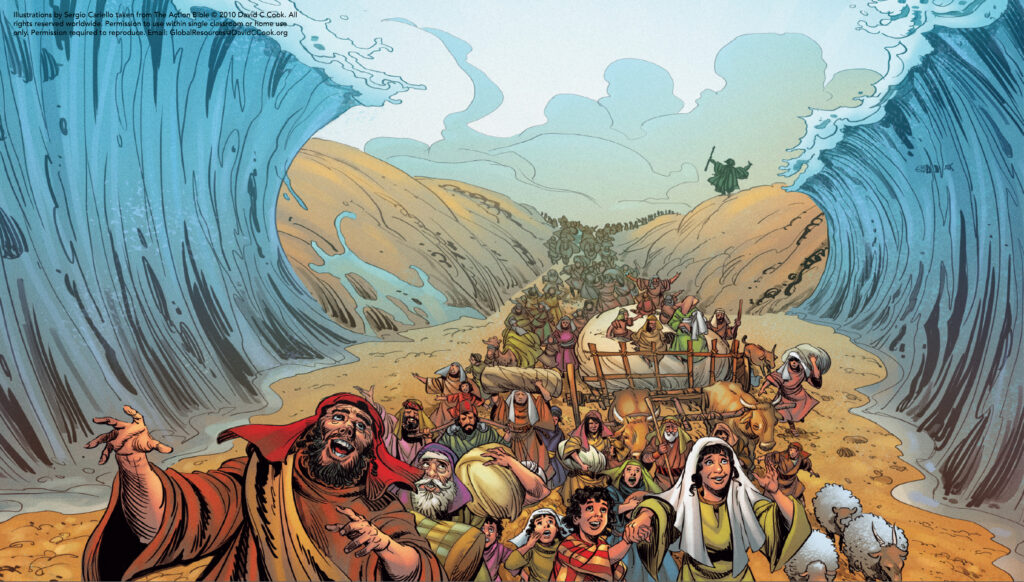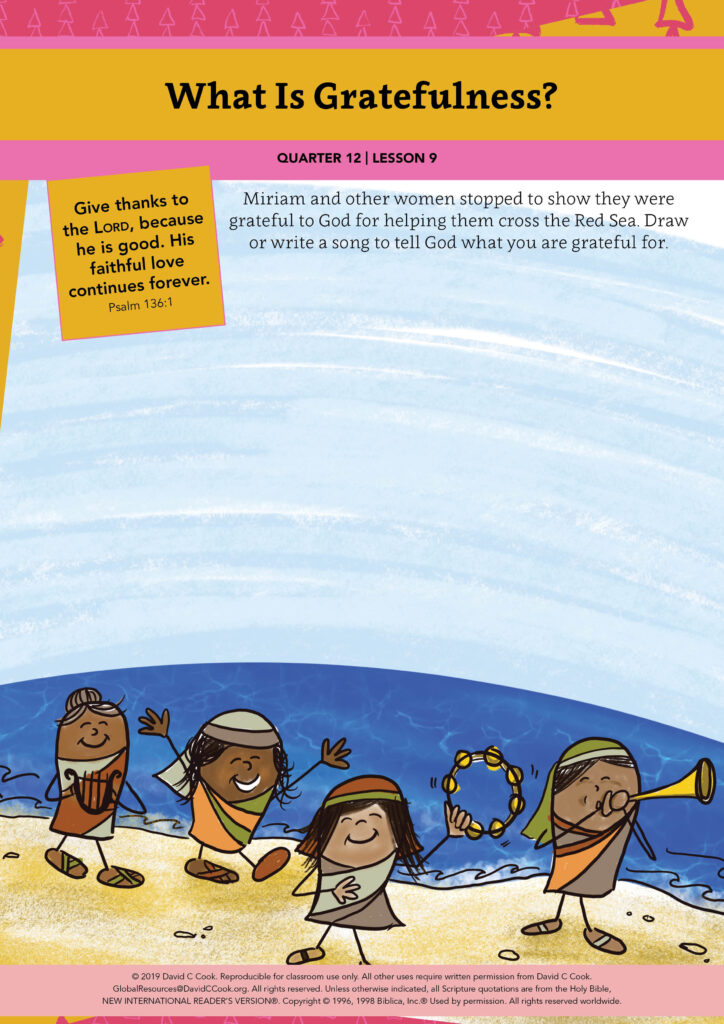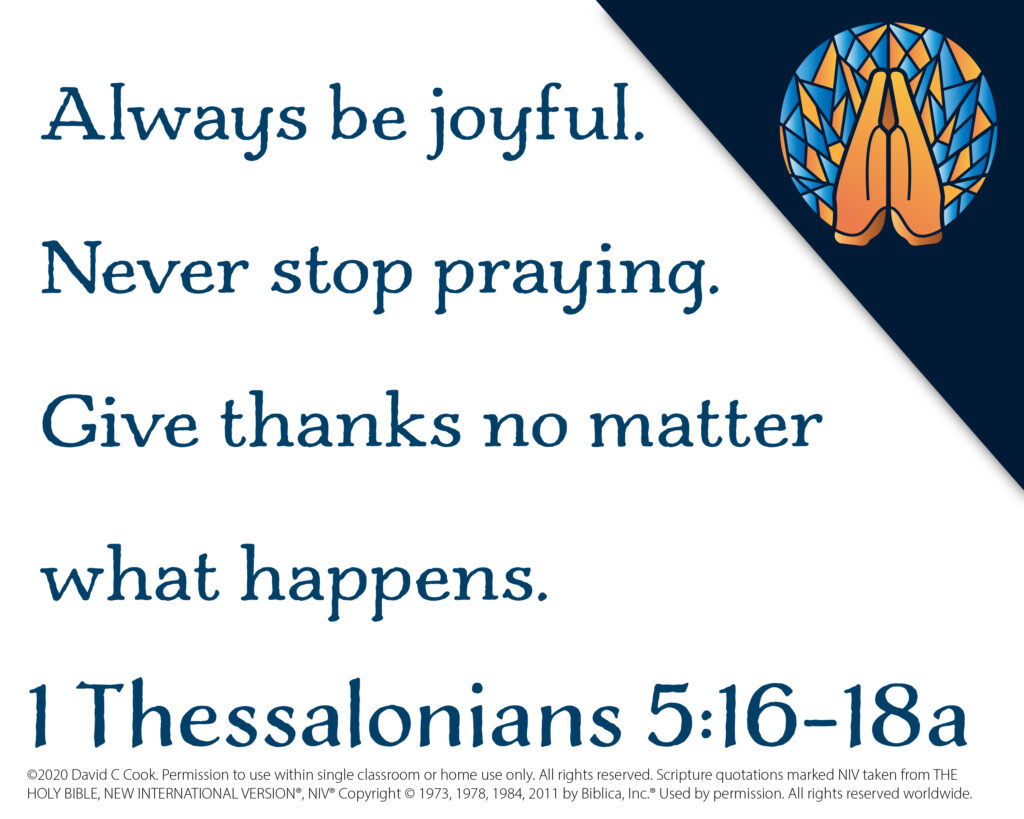During the lesson, the information for you to know is written in regular type, and what we suggest speaking or reading aloud to children is in bold. All resources for this lesson, including the Teacher Guide, Student Page, Family Connection Card, and other resources can be downloaded in a ZIP file by clicking on the following link:
In some lessons you will find "resource articles." These are articles written by experts from around the world to help equip you for your work with children and adolescents. Share them with parents or guardians if you consider it appropriate.
Before class, clear a large area in your teaching space so that the children may easily move around the space. You will need this for the Teaching section of the lesson.
Also, look at the Responding section and think of a melody to use for the song. You may choose to use a melody most of the children will know, or you may choose to create your own.
Always be joyful. Never stop praying. Give thanks no matter what happens. God wants you to thank him because you believe in Christ Jesus.
1 Thessalonians 5:16–18
Giving thanks to God is good for us! When we focus on what we are grateful to God for, we may be calmer and more relaxed, we may sleep better, our bodies may be better able to fight illness, and we may feel happier. Giving thanks also helps us to remember God’s faithfulness to us, even in difficult times. He is the God who parted the Red Sea to save His people, and He sent Jesus to save you! No matter what happens in our lives, we can always pray, always be joyful, and always give thanks for what He has done.
Think of something that has happened in the past year, in the past week, and in the past day that you can be thankful to God for. Take a moment to be still in God’s presence and give thanks for all He has done for you. After thanking God, ask Him to give you a grateful heart so you will not miss the wonderful things He is doing in your life. And, as you begin each day, thank Him for something new so that you will remember to come into His presence with joy and gratefulness.
Encourage families to name things they are grateful for, including being grateful for one another! If possible, suggest that they pray to God to tell Him what they are grateful for.
Teacher Tip: If possible, email or text the Family Connection Card to the families of your students.
Welcome each child to class with a high five. As you welcome the children, tell them you are grateful they came to class.
Today, let’s start by creating a calm and peaceful space to learn. Think of some things that make you happy and calm. You can think of people, places, or things. Some examples are family members, kind classmates, a place for your family to live, or a beautiful sunset you saw. When you have thought of something that makes you happy and calm, put 1 thumb up.
Allow children to think for about 30 seconds or until most children put their thumbs up. Then have the children stand up with you. As you read each of the steps below, do the action with the children. You will breathe in, hold your breath, and breathe out. For each step, you will also count to 3.
Take a deep breath in as you silently count to 3 with your fingers.
Take a deep breath. While you take a deep breath, hold up 3 fingers, 1 at a time, to demonstrate counting to 3.
Hold your breath while you silently count to 3 with your fingers.
Show that you are holding your breath. While you hold your breath, hold up 3 fingers, 1 at a time, to demonstrate holding your breath for 3 seconds.
As you breathe out slowly, think of 1 thing that makes you happy and calm.
Encourage the children to breathe out with you. Breathe out slowly and in a way that allows the children to hear you breathing.
Great! Now, let’s do this activity again. This time, pay attention to how your body feels as you breathe in and out. Remember to breathe in, pause, and breathe out as you think of something that is happy.
Repeat the activity 2 times with the children. After step 2, remind the children to think of something that makes them happy and calm.
How do you feel when you take deep breaths and think of things that make you happy and calm?
Allow 2–3 children to respond.
When we are grateful for something good in our lives, it can help us to feel happy and calm. Today, we will learn what it means to be grateful.
If thinking about good things helped you to feel more relaxed, raise your hand.
If thinking about good things helped you feel like there will be good things for you in the future, raise your hand.
Most of you raised your hands. That is because this activity helped us to focus on things we are grateful for.
To be grateful for something, you must first notice things in your life that you are happy about. Then you show you are thankful for those things through your words and actions. Often that means thanking or doing something kind for a person who was kind to you or gave you something good. We can also be grateful to God for the good things He does and for who He has created us to be.
When we are grateful, we can feel happy, calm, and hopeful!
Optional: If you are using The Action Storybook Bible, show the children the pictures on pages 80–83 as you tell the story of how the Israelites left Egypt.
The Bible tells many stories about people who were grateful. Today, you will hear the true story about Moses, his brother Aaron, and his sister Miriam who were grateful to God for freeing the Israelites—God’s people—from slavery in Egypt. Before I tell you this story, I need 2 volunteers.
Stand at 1 end of the teaching space. Call on 1 child to pretend to be Moses and 1 child to pretend to be Pharaoh. Have them stand next to you. Ask the rest of the class to stand near you.
For many years, the Israelites had been working for the king of Egypt—Pharaoh—doing very difficult work.
Ask the children to pretend to lift heavy objects and dig in the dirt.
The Israelites were not treated well by the Egyptians. This was a very difficult time for the Israelites.
Encourage the children to hunch over or bend down to the ground to show they are tired.
God sent Moses to ask Pharaoh to free the Israelites. Moses asked Pharaoh many times to free the Israelites, and each time he said, “No.” God sent many harmful things to Egypt to try to get Pharaoh to set His people free.
Ask the child pretending to be Moses to say, “Set my people free.” Have the child pretending to be Pharaoh say, “No!”
Pharaoh finally agreed, so the Israelites left Egypt.
Have the child pretending to be Pharaoh say, “Go!” Then have the rest of the class walk together to a part of the space that is away from “Pharaoh.” Be sure you are standing next to “Pharaoh.”
After the Israelites left, Pharaoh wondered who would do all of the work the Israelite slaves had been doing. So, he sent soldiers in chariots to chase after the Israelites.
You will represent the soldiers. Begin walking toward the group of children. You will not reach the place where the children are, so walk very slowly.
Optional: If possible, share the images from The Action Bible.


As Moses led the Israelites out of Egypt, they came to a big body of water called the Red Sea. They could not go around it because it was too big. They did not have any boats to get across. The Israelites saw that the Egyptians were coming after them, and they began to worry.
Have the children look at you as you come toward them. Then have them look in front of them.
Listen to what God told Moses to do next:
If possible, read this verse directly from your Bible.
Hold out your walking stick. Reach out your hand over the Red Sea to divide the water. Then the people. can go through the sea on dry ground.
Exodus 14:16
Moses did exactly what God said, and God performed a miracle. In a sea so big and so deep that the Israelites would not have been able to get through it, God made a dry path for His people to walk through! That was amazing! Only God could do something as amazing as that!
Ask the child pretending to be Moses to reach out his hand. Have the rest of the children pretend to walk across “the sea.”
After the Israelites walked to the other side of the sea, the path was covered over with water. The Egyptians could not get to the Israelites! God had saved His people!
Walk over to where the children are and stop just before you get to them. If you have a piece of cloth or a scarf, explain to the children that this represents the water. Then put it out in front of you. Thank the children for helping you tell the story. Have them sit in a circle in the middle of the space.
How do you think the Israelites felt after they crossed the Red Sea?
Allow 2–3 children to respond. Possible answers include: happy, excited, and grateful.
I would be grateful to be out of Egypt. Moses, his sister Miriam, and his brother Aaron were grateful, too. Listen to what happened next:
Aaron’s sister Miriam was a prophet. She took a tambourine in her hand. All the women followed her. They played tambourines and danced. Miriam sang to them, “Sing to the Lord. He is greatly honored.”
Exodus 15:20–21a
How did the Israelites show they were grateful to God?
Allow 1–2 children to respond.
Some of the Israelites showed gratefulness to God by singing, dancing, and playing music. Long after this miracle happened, God’s people still remembered the event. Listen to the words of this song that was written many years later:
Give thanks to the Lord, because he is good. His faithful love continues forever…. Give thanks to the God who parted the waters of the Red Sea. His faithful love continues forever. He brought Israel through the middle of it. His faithful love continues forever.
Psalm 136:1, 13–14
Songs can help us to remember good things that have happened to us. We can sing them when we are grateful or when we need hope for our lives. Singing songs is 1 way to show we are grateful for the good things in our lives.
What do you do when you are grateful?
Allow 2–3 children to respond.
Singing, making music, thanking people, and giving people gifts are some of the many ways we can show we are grateful to God and to others for good things!
Have the children get into groups of 2–3 children.
To tell God what we are grateful for, let’s create songs. Here is an example of a grateful song:
I am grateful, so grateful for this class. I am grateful, so grateful for this class. I am grateful, so grateful for this class. I am grateful, so I will sing this song!
There are many things we can be grateful for. We can be grateful for the love of a family member, the kindness of a friend, having our needs met, and many other things. Take a moment to think of 2 things you are grateful for. When you have thought of the 2 things, put 1 thumb up.
Allow children to think for about 30 seconds or until most children have their thumbs up.
Share what you are grateful for with the children in your group.
Give the children 1–2 minutes to share in their groups.
Now, let’s use some things you are grateful for to create a song. The words to the song are “I am grateful, so grateful for _____.”
Encourage the children to repeat the words of the song with you 3 times.
At the end of each line of the song, I will pause. When I pause, I will call on someone to say something she is grateful for.
Encourage the children to sing this song with you. Pause where there are blank lines and call on a child to name something he is grateful for. Do this for each blank line in the song.
Now that we have sung a song to show we are grateful, you will create a grateful song in your groups. Be sure to use at least 1 idea from each person in your group as you sing your songs. You may use the song we just sang, or your group can make up a new song.
Allow 3–5 minutes for the children to create their songs. Walk around the teaching space as the children work on their songs, and offer help if the groups are struggling to complete the task.
Optional: If you are using the Student Pages, give the children crayons and allow 2–3 minutes for the children to draw or write their songs.

Who would like to share a grateful song with the class?
Allow 3–4 groups to share their songs for the class.
Your beautiful songs tell me there are many things you are grateful for. When you think about what you are grateful for, it helps you to be happier, calmer, and more hopeful. This week, I encourage you to celebrate what you are grateful for by singing the song you sang today. You can also try singing about different things you are grateful for each day. Our memory verse reminds us that we should always be grateful.
If you are using the Memory Verse Poster, show it to the students.
Always be joyful. Never stop praying. Give thanks no matter what happens.
1 Thessalonians 5:16–18a

Create a rhythm by clapping to the words of these verses. Teach this rhythm to the children, and encourage them to say the words and clap the rhythm with you 3 times.
End class by saying this blessing, based on Psalm 136:1, over the children.
Blessing: May you give thanks to God and to others. May you be grateful to God for His faithful love!
Lead the children in singing this quarter’s song, if possible.
Life on Life ©2020 David C Cook. Reproducible for home or classroom use only. All other uses require written permission from David C Cook [email protected]. All rights reserved.